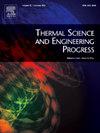IF 5.1
3区 工程技术
Q2 ENERGY & FUELS
引用次数: 0
摘要
随着高超音速飞行器马赫数的不断提高,不同热通量密度下的气动加热效应对扰流喷气发动机的热保护提出了重大挑战。为准确预测其热保护特性,本研究采用瞬态热-流-固耦合方法研究了不同时间实例下的非稳态热-水力特性和壁面变形,重点研究了典型再生冷却通道和喷气再生冷却通道内超临界正癸烷的流动、传热和热应力等问题。结果表明,增加热流密度会改变通道内的横流结构,导致涡旋中心位置和再循环区向下移动。相比之下,射流撞击导致的涡流形成和发展则表现出良好的稳定性。较高的热通量不利于通道内的流体混合,带来传热恶化(HTD)的潜在风险,而射流撞击则表现出出色的局部冷却性能。等效应力与时间无关,主要集中在通道表面的边缘和中心线,在这些位置发生断裂的风险相对较高。这项研究的结果将为再生冷却通道的结构设计和热保护性能提供理论支持。本文章由计算机程序翻译,如有差异,请以英文原文为准。
Enhanced transient flow and heat transfer analysis in diverse regeneration cooling modes incorporating thermal-fluid-structure interaction effects
As the Mach number of hypersonic vehicles continues to increase, the aerodynamic heating effects at varying heat flux densities pose significant challenges to the thermal protection of scramjets. To accurately predict their thermal protection characteristics, this study employs a transient thermal-fluid–solid coupling method to investigate the unsteady thermal–hydraulic properties and wall deformation at different time instances, focusing on issues such as flow, heat transfer and thermal stress in supercritical n-decane within typical regeneration cooling channels and jet-regeneration cooling channels. The results reveal that increasing the heat flux density alters the crossflow structure within the channel, causing the vortex center location and recirculation zones to shift downwards. In contrast, the formation and development of vortices due to jet impingement exhibits good stability. Higher heat fluxes are detrimental to fluid mixing within the channel, posing a potential risk for heat transfer deterioration (HTD), whereas jet impingement demonstrates excellent localized cooling performance. The equivalent stress, which is independent of time, is predominantly concentrated at the edges and centerline of the channel surface, where the risk of fracture is relatively high. The findings of this study will provide theoretical support for the structural design and thermal protection performance of regeneration cooling channels.
求助全文
通过发布文献求助,成功后即可免费获取论文全文。
去求助
来源期刊

Thermal Science and Engineering Progress
Chemical Engineering-Fluid Flow and Transfer Processes
CiteScore
7.20
自引率
10.40%
发文量
327
审稿时长
41 days
期刊介绍:
Thermal Science and Engineering Progress (TSEP) publishes original, high-quality research articles that span activities ranging from fundamental scientific research and discussion of the more controversial thermodynamic theories, to developments in thermal engineering that are in many instances examples of the way scientists and engineers are addressing the challenges facing a growing population – smart cities and global warming – maximising thermodynamic efficiencies and minimising all heat losses. It is intended that these will be of current relevance and interest to industry, academia and other practitioners. It is evident that many specialised journals in thermal and, to some extent, in fluid disciplines tend to focus on topics that can be classified as fundamental in nature, or are ‘applied’ and near-market. Thermal Science and Engineering Progress will bridge the gap between these two areas, allowing authors to make an easy choice, should they or a journal editor feel that their papers are ‘out of scope’ when considering other journals. The range of topics covered by Thermal Science and Engineering Progress addresses the rapid rate of development being made in thermal transfer processes as they affect traditional fields, and important growth in the topical research areas of aerospace, thermal biological and medical systems, electronics and nano-technologies, renewable energy systems, food production (including agriculture), and the need to minimise man-made thermal impacts on climate change. Review articles on appropriate topics for TSEP are encouraged, although until TSEP is fully established, these will be limited in number. Before submitting such articles, please contact one of the Editors, or a member of the Editorial Advisory Board with an outline of your proposal and your expertise in the area of your review.
 求助内容:
求助内容: 应助结果提醒方式:
应助结果提醒方式:


